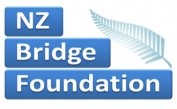
Diamonds means diamonds
Wondering if anyone has a view on this. At the club tonight the opps had the auction
1NT - 2D (alerted)
2H - 3D.
Responder intended this to show long diamonds saying nothing about hearts at all.
I was sitting in fourth seat with 6x hearts to the king. The above auction wasn't actually the auction, as my partner doubled opener's 2H bid for take-out, which didn't really surprise me. Given I was void in diamonds, I decided to compete to 3S, thinking I would be able to do a lot of cross-ruffing. When dummy hit with a couple of hearts I was surprised to say the least.
Post-hand, I asked opener if she knew that 3D "cancelled" the initial meaning of 2D, and as they were a fairly casual partnership but had played before she hemmed and hawed a bit and said probably. Responder was adamant that this was a "standard" method to get to a long diamond suit when you played transfers. I assumed standard was that this showed 5-4 or more extreme in hearts and diamonds.
We were shut out of the par contract of 2H, but had I known what was going on I might have passed or doubled 3D and opted to defend, which would have got us a plus score rather than the -50 we got.
Given all 2D bids after 1NT are alerted, and given the 3D bid was "natural" whether it showed 5-4 or 1-6 in the red suits, I'm wondering at what point I should have learned what was going on here.
Do I have to ask for an explanation of all alerted bids - even 2D or 2H - after 1NT? [Had I asked, I'm 99% sure I would have been told "transfer" and nothing more...]
Do I have to ask for an explanation of unalerted natural bids to see if they change the meaning of earlier bids?
Latest Posts on this Thread
- NICK WHITTEN31 Mar 2018 at 02:46PM
Hi Matt
I also have a problem as a director making a ruling in this situation
I would like a National Director to clarify this situation on this forum PLEASE
(or if there is a better way rather than this forum to have questions like this answered by an expert WHAT IS IT?)In particular:
Is it reasonable for a pair to treat this sequence as a "standard" way to make a weak takeout in diamonds?And how and when should they convey this to the opponents?
And does a pair who doesn't ask about the alerted 2D bid lose their rights to rectification if damaged in a situation like this?
cheers
Nick - GILES HANCOCK02 Apr 2018 at 04:09PM
Hi
There's also a question of how the 2D bid is explained. "5+ hearts OR 5+ diamonds" ?
(Personally I think a lot of the time this will be an unethical sequence, responder has long diamonds and has forgotten that they play transfers.)
I do the same with some partners with 1NT - 2C - 2any - 3C which is a hand with long clubs, 3C is to play. It may contain a 4-card Major but it doesn't promise one.
a) should the 2C bid be alerted ? or is it just bridge ?
b) if asked, should I say "asking for a 4-card Major; could just be weak with long clubs."
- Giles
- NICK WHITTEN02 Apr 2018 at 06:45PM
Hi Giles
Thats a very good point about "unethical sequence" IMO
I think any who use that sequence should need to prove they haven't just forgotten the transfer
By a system card on the tableUnless it was asked about and correectly explained by the 2D bidder's partner
But I think the 2C sequence is different
There is no easy alternative way to show weak with long clubs when not using transfers.
But players using transfers can use 2S or 2NT for a weak minor suit takeoutSo I think the possibility of 2C being possibly weak with long clubs is a "matter generally known to bridge players" and therefore not requiring an alert
But I know others disagree with that
And of course there is no harm done with an "unnecessary" alertAnd, yes, if you choose to alert and are asked, definitely explain as you said in (b)
cheers
Nick - Ed Roggeveen15 Apr 2018 at 08:05AM
I'm struggling to see how there can be any debate here as the Manual us very clear.
Matt - in your original example, the 2D should have been alerted and so should the 3D because "The bid is natural, but you have an agreement by which your bid is forcing or non-forcing in a way that your opponents are unlikely to expect." Despite protestations to the contrary, this is not "standard" on their part. Had you asked what he alerted 2D meant (and here we have learned not to make assumptions about what alerted bids mean) you should have been told something like "transfer to hearts but it could be corrected back to 3D if partner has a weak diamond hand". Had you just been told "transfer" without the other information then there has been an infraction and you may well have a case to claim damage and an adjusted score. At the very least the opposition would have been given a warning and told to fully disclose the meaning of the bid or face a procedural penalty.
Nick - I'm sorry but you are wrong with your 2C statement. The Manual defines self-alerting calls, giving the example: "simple Stayman 2♣ responses to 1NT opening bids and the 2♦ response denying a 4-card major (alert all other uses including a natural 2♣ and responses)." Having a weak club suit as an option is NOT simple stayman and, as the vast majority of players in NZ are Junior / Intermediate I refute entirely your assertion that "the possibility of 2C being possibly weak with long clubs is a "matter generally known to bridge players".
It is absolutely 100% alertable and I am flummoxed as to how you can say otherwise when NZB regulations say it is. As a Director you don't have to agree with the rules / regulations (I disagree with many) but you do have to enforce them.
Regards
Ed - NICK WHITTEN22 Apr 2018 at 08:25AM
Hi Ed
Your quotes from the Manual highlight the ambiguity there
"2C is self-alerting"
and
"2C (if used to also include the possibility of a weak club hand) is 100% alertable
The Manual also says "self-alerting calls should not be alerted"
Go figure
The best way to "go figure" is to see if failure to alert would cause damage
For my part I can't think of any hand I might hold which would call for a different immediate action over
[a] 2C as Stayman but which might include the possibility of a weak club hand
or
[b] 2C as Stayman but excludes that possibilityCan anyone else make up such an example?
If not then there is no damage done by a failure to alert
cheers
Nick - Ed Roggeveen22 Apr 2018 at 08:43AM
I hold the hand:
S:x
H:AT
D:KJxx
C:AQJxxx
Auction is 1NT - P - 2C to me. The 2C is simple stayman so I bid 3C.
The auction is 1NT - P - 2C to me. The 2C is alerted as it could have a weak club. Now I pass and wait. If the auction continues 1NT - P - 2C - P - 2H - P - P I can still bid 3C. But if it goes 1NT - P - 2C - P - 2H - P - 3C now I double. All my regular partners will know in this sequence it is for penalties.
So my immediate action over the 2C is quite different with this hand. If the 2C was not alerted (and indeed was the hand with the club suit )and I bid 3C with my hand my +300 has just become +110 or maybe even -50. So I think the failure to alert has damaged me quite significantly!
Cheers
Ed - Dougal WATSON22 Apr 2018 at 01:28PM
Hi Matt
I am no expert, but am trying to hone my Director skills in anticipation of an exam later this year. So, here’s how I’d view your situation, fully acknowledging that that view may change as I learn more … or others jump in and correct me. These are my thoughts, and mine alone. Just my tuppence

- During the auction you are absolutely able to ask the meaning of any bid when it’s your turn to call (Law 20F1). The same applies during the clarification period after the bidding stops but before the opening lead card is ‘faced’ (Law 20F1). As a defender you’re even able to ask during the play (Law 20F2). Not only that but your opponents have a duty to make their partnership understandings available to you – fully and thoroughly. It should not be a cat-and-mouse process where you need to ask the right questions to get the information, your opponents are obliged to ensure that you are readily able to understand their system and their bids.
- The precise meaning of a particular call will depend on the partnership understanding. That understanding can be explicit, written down in detail, or implicit through experience and understanding (Law 40A).
- It is legal for someone to bid in a manner that is different to their system agreement, providing that their partner has no more reason than their opponents to be aware of that deviation from their agreement (Law 40C1). In such a situation no player is obliged to disclose to the opponents that they have deviated from their announced system agreement (Law 40C2).
- You should have called the Director as soon as you became aware of the irregularity (Law 9B1), even if that was after the hand had been played out.
Could you have sought further information?
Yes … but in the circumstances described I am not sure it’d have helped you much.
Should your opponent’s have provided further detail?
From your description it seems that your opponents had slightly different understandings of the precise details of their agreement. Quite likely such things were not explicitly and thoroughly discussed.
Does a 2D! transfer response to a 1NT opener absolutely require a 5+ card holding in hearts?
If their system agreement was that 2D! showed 5+ hearts then that bid requires the holding of 5+ hearts … subject to the discussion below.
I just checked the system card I have with my main partner and it says simply that 2D! in that situation is a “Transfer to hearts”. I suppose such a transfer implies a 5+ card heart holding, but it probably does not preclude just the sort of bidding sequence you experienced. An expert player might well use just such a sequence to bamboozle the opponents (and their partner) and try to prevent the opponents from finding a heart fit.
All the same it’s entirely reasonable to anticipate that 2D! bid as showing or suggesting a holding of 5+ hearts. I suspect you’d have been told as much if you enquired further during the auction. Such a transfer, though, would not necessarily exclude a 2-suiter and so the sequence you describe seems entirely do-able … except for the problematic absence of hearts.
Do players sometimes deliberately misrepresent their hand?
Absolutely. There was a nasty hand in our recent interclub competition where a suit overcall, based on a 1HCP holding, derailed the finding of a slam. Two pairs made that overcall and I will wager their system card did not say anything along the lines of “May be as low as zero HCP”. I held that hand and was not skilled enough to make that call, so our opponents found the slam.
Similarly, there are players who will quite quickly discern where their weakness is and distract their opponents via a deliberately misleading bid.
On the other hand, some partnerships have some very liberal meanings of their bids, especially overcalls. Their liberal nature, however, is usually written into their system agreement (may be very weak) or explained at the table.
Is it legal to bid in a way that misrepresents your hand?
It is entirely legal to do this … providing your partner is just as ‘in the dark’ about the bid as your opponents are. You cannot have a secret agreement that is not ‘available’ to your opponents.
Such “psychic bids” can disrupt both sides in a bidding competition, but when used skilfully they can also provide advantage to the psychic bidder’s partnership. Clubs and tournaments often have rules about how often people can ‘psych’ and that require such bids to be registered. The main reason for this is to make sure the psychic bids are not actually a secret element of the partnership agreement.
Were your opponents’ psyching you?
That does not seem likely. It seems more likely that your two opponents had a slightly different understanding of the details of their agreement. It’s also possible that at least one of them had a misunderstanding of how to show minor suits in response to a NT opening bid.
Did your opponents do anything wrong?
If I were in your situation I’d have anticipated that sequence to be showing 5+ hearts and 4+ diamonds and, like you, I’d have been very reticent to explore my long heart holding much further. Better players, I suspect, may well have explored their heart holding despite that transfer bid … because their greater experience would have previously exposed them to just that sort of bid.
It seems, from your explanation, that your opponents provided you with appropriate information to the best of their knowledge. It also appears that your partners had an incomplete, even different, understanding of the details of their system agreement. That is not terribly unusual at club sessions where partnerships often have not had the opportunity (or inclination, or skill) to develop the details of their system.
If you had been correctly and thoroughly advised concerning that bidding sequence, it’s not likely you’d have been any the wiser. The 2D! bidder appears to have had a different understanding of the meaning of that bid to their partner.
Did you do anything wrong?
You could have asked more of your opponents, but it doesn’t seem likely that that’d have helped much. Had you explicitly asked more about the transfer you’d have probably been advised that it shows or implies 5+ hearts held.
Perhaps a more expert player would have had the experience and confidence to bid their heart holding despite that transfer, perhaps not.
In such a situation, once you’ve noticed the irregularity, the proper thing to do is to call the Director (Law 9B1). It’s then up to the Director to determine whether anything has occurred that requires rectification (Law 10). It’s important to not try and fix an issue yourself at the table, but to call the Director. Law 11 says that you can forfeit the right to rectification if you (the non-offenders) take action other than calling the Director. The Director is often able to rectify things, when the non-offending pair is disadvantaged by the offences, some time afterwards … so it’s always appropriate to call the Director when you notice an irregularity.
All the same I am not confident that the Director would have rectified any aspect of what you described.
Can this be fixed?
I’m afraid there appears to be nothing here to be fixed. Your opponents do not seem to have acted inappropriately, within the constraints of an imperfectly understood partnership agreement being played out on a club night session.
As I see it the main remedy here is more experience, for all parties. You will experience more such happenings, both erroneous and deliberate, and will become more confident in handling them.
Cheers
Dougal - NICK WHITTEN23 Apr 2018 at 09:21AM
That sequence “normally” shows hearts AND diamonds
And if it is diamonds only – then it must be alerted
But hey it WAS alerted
Therein lies the problemIf you got lazy and neglected to ask about an alerted bid (because you thought you knew what it was) then you have no redress if it turned out to be something else.
But, as Giles pointed out, it is likely the responder forgot they were playing transfers until partner alerted then rectified the situation.
THAT is illegalAnd IMO quite likely
Click here to log in.






